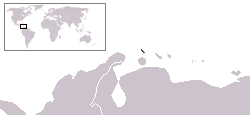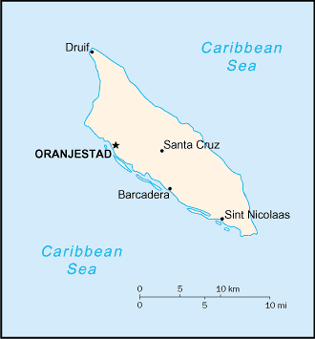Aruba
|
|
Aruba is an island in the Caribbean Sea, just a short distance north of the Venezuelan Paraguaná Peninsula, and it forms a part of the Kingdom of the Netherlands. Unlike much of the Caribbean region, it has a dry climate and an arid, cactus-strewn landscape. This climate has helped tourism, however, as visitors to the island can reliably expect warm, sunny weather.
ÚÀÌ
| |||||
| National motto: None | |||||

| |||||
| Official language | Dutch | ||||
| Political status | Dependent area of Netherlands | ||||
| Capital | Oranjestad | ||||
| Queen | Beatrix | ||||
| Governor | Fredis Refunjol | ||||
| Prime Minister | Nelson O. Oduber | ||||
| Area - Total - % water | (Not ranked) 180 km² Negligible | ||||
| Population
| (Ranked 187)
| ||||
| Currency | Aruban Florin | ||||
| Time zone | UTC -4 | ||||
| National anthem | Aruba Dushi Tera | ||||
| Internet TLD | .aw | ||||
| Calling Code | +297 | ||||
| Contents |
History
Main article: History of Aruba
Discovered and claimed for Spain in 1499, Aruba was acquired by the Dutch in 1636. The island's economy has been dominated by three main industries. A 19th-century gold rush was followed by prosperity brought on by the opening in 1924 of an oil refinery. The last decades of the 20th century saw a boom in the tourism industry.
Aruba seceded from the Netherlands Antilles on January 1, 1986, and became a separate, autonomous member of the Kingdom of the Netherlands. Movement toward full independence was halted at Aruba's request in 1990.
Politics
Main article: Politics of Aruba
Head of state is the ruling monarch of the Netherlands, who is represented in Aruba by a governor, appointed for a six-year term. The head of government is the prime minister, who forms, together with the Council of Ministers, the executive branch of the government.
They are elected by the parliament, the unicameral Legislature or Staten, which holds 21 seats. Members are elected by direct, popular vote to serve four-year terms.
Geography
Main article: Geography of Aruba
Aruba is a generally flat, riverless island renowned for its white sand beaches. Most of these are located on the western and southern coasts of the island, which are relatively sheltered from fierce ocean currents. The northern and eastern coasts, lacking this protection, are considerably more battered by the sea and have been left largely untouched by humans. The interior of the island features some rolling hills, the better two of which are called Hooiberg at 165 m (541 ft) and Mount Jamanota, which is the highest on the island, at 188 m (617 ft) above sea level.
As a separate part of the Kingdom of the Netherlands, the island has no administrative subdivisions. On the east are Curaçao and Bonaire, which form the southwest part of the Netherlands Antilles; the three islands are known collectively as the ABC islands.
The local climate is a pleasant tropical marine clime. Little seasonal temperature variation exists, which helps Aruba to attract tourists all year round. Temperatures are almost constant at about 28 degrees Celsius (85 degrees Fahrenheit), moderated by constant trade winds from the Atlantic Ocean. Yearly precipitation barely reaches 500 mm (20 inches), most of it falling in late autumn.Economy
Main article: Economy of Aruba
Aruba enjoys one of the highest standards of living in the Caribbean region, with low poverty and unemployment rates. About half of the Aruban Gross National Product is earned with tourism or related activities. Most of the tourists are from the Americas, notably the United States, which is the country's largest trading partner. Oil processing is the dominant industry in Aruba, despite expansion of the tourism sector. The size of the agriculture and manufacturing industries remains minimal.
Deficit spending has been a staple in Aruba's history, and modestly high inflation has been present as well, although recent efforts at tightening monetary policy may correct this. Aruba receives some development aid from the Dutch government each year. The Aruban guilder has a fixed exchange rate with the United States dollar of 1.79:1.
Demographics
Aruba-demography.png
Having poor soil and aridity, Aruba was saved from plantation economics and the slave trade. In 1515, the Spanish transported the entire population to Hispaniola to work in the copper mines; most were allowed to return when the mines were tapped out. The Dutch, who took control a century later, left the Arawaks to graze livestock, using the island as a source of meat for other Dutch possessions in the Caribbean. The Arawak heritage is stronger on Aruba than on most Caribbean islands. No full-blooded Indians remain, but the features of the islanders clearly indicate their genetic heritage. The majority of the population is descended from Arawak, Dutch and Spanish ancestors. Recently there has been substantial immigration to the island from neighboring Latin American and Caribbean nations, attracted by the lure of well-paying jobs.
Although the official language is Dutch, Papiamento, classified as a Portuguese Creole, is predominant. This creole language is formed primarily from Dutch, Spanish, and Portuguese, with some elements from English, and other languages. Spanish and English are also spoken. Islanders can often speak four or more languages.
The majority of the population are followers of Christianity, and are mostly Roman Catholic.
Population: 103,000( April 2004 est.)
Age structure:
- 0-14 years: 20.7% (male 7,540; female 7,121)
- 15-64 years: 68.3% (male 23,427; female 24,955)
- 65 years and over: 11% (male 3,215; female 4,586) (2003 est.)
Median age:
- total: 37.1 years
- male: 35.3 years
- female: 38.5 years (2002)
Population growth rate: 0.55% (2003 est.)
Birth rate: 11.86 births/1,000 population (2003 est.)
Death rate: 6.38 deaths/1,000 population (2003 est.)
Net migration rate: 0 migrant(s)/1,000 population (2003 est.)
Sex ratio:
at birth: 1.05 male(s)/female
under 15 years: 1.06 male(s)/female
15-64 years: 0.94 male(s)/female
65 years and over: 0.7 male(s)/female
total population: 0.93 male(s)/female (2003 est.)
Infant mortality rate:
- total: 6.14 deaths/1,000 live births
- female: 5.25 deaths/1,000 live births (2003 est.)
- male: 6.99 deaths/1,000 live births
Life expectancy at birth:
- total population: 78.83 years
- male: 75.48 years
- female: 82.34 years (2003 est.)
Total fertility rate: 1.79 children born/woman (2003 est.)
Nationality:
noun: Aruban(s)
adjective: Aruban; Dutch
Religions: Roman Catholic 82%, Protestant 8%, Hindu, Muslim, Confucian, Jewish
Languages: Dutch (official), Papiamento (a creole of Spanish, Portuguese, Dutch, English and indigenous roots), Spanish, English.
Culture
Main article: Culture of Aruba
The origins of the population and location of the island give Aruba a mixed culture. Dutch influence can still be seen, even though not much of the population is of Dutch origin. Tourism from the United States has recently also increased the visibility of American culture on the island. Queen Beatrix International Airport, located near Oranjestad, Aruba, currently serves the whole island of Aruba. This airport has access to various cities across the eastern U.S., from Miami, Orlando, Houston, Atlanta to New York. It also connects Aruba with Europe through the Schiphol Airport in the Netherlands.
The holiday of Carnival is an important one in Aruba, as it is in many Caribbean and Latin American countries. Carnival is usually held from the beginning of January until the end of February, with a large parade on the final Sunday of the festivities.
See also: Music of Aruba and the Netherlands Antilles
- Aruba Culture - Caribbean Adventures (http://www.greatcaribbeanadventures.com/aruba/culture.asp)
Places of interest
Natural_bridge_aruba.jpeg
- Arikok National Park
- Ayo and Casibari Rock Formations
- California Lighthouse (http://www.thejanskys.org/lighthouse/Other/calif.html)
- Palm and Eagle Beaches
- Natural Bridge (http://www.thespecks.com/Aruba/Aruba2000/natbridge.html)
- Natural Pool
- Frenchman's Pass
- Alto Vista Chapel
- Lourdes Grotto
- Hooiberg
Miscellaneous topics
External links
- Aruba.com (http://www.aruba.com/) - Official governmental portal
- Library of Congress Portals on the World - Aruba (http://www.loc.gov/rr/international/hispanic/aruba/aruba.html)
- CIA - The World Factbook -- Aruba (http://www.cia.gov/cia/publications/factbook/geos/aa.html) - CIA World Factbook on Aruba
- An island map of Aruba (http://www.caribbean-on-line.com/islands/ar/armap.shtml) and a detailed map of Oranjestad (http://www.caribbean-on-line.com/islands/ar/ormap.shtml) are available at Caribbean-On-Line.com
- Map (http://www.arubatravelinfo.com/maps/arubamap.gif)
- Aruba Ecards (http://www.aruba-ecards.com/) - Images of Aruba
- Financial institutions in Aruba (http://based.in/?Aruba)
- Aruba Airport Authority (http://www.airportaruba.com/)
- Aruba Aloe (http://www.arubaaloe.com/)
- Aruba Bound! (http://www.arubabound.com/)
- N.V. Elmar (http://www.elmar.aw/info/content/default.jsp) - Aruba's electric utility
| Countries in West Indies |
|---|
|
Antigua and Barbuda | Bahamas | Barbados | Cuba | Dominica | Dominican Republic | Grenada | Haiti | Jamaica | Saint Kitts and Nevis | Saint Lucia | Saint Vincent and the Grenadines | Trinidad and Tobago |
|
Dependencies: Anguilla | Aruba | British Virgin Islands | Cayman Islands | Guadeloupe | Martinique | Montserrat | Navassa Island | Netherlands Antilles | Puerto Rico | Turks and Caicos Islands | U.S. Virgin Islands |
| | Missing image Caricom-Flag.png Flag of the Caribbean Community |
|---|---|
| Antigua and Barbuda | Bahamas¹ | Barbados | Belize | Dominica | Grenada | Guyana | Haiti | Jamaica | Montserrat | Saint Kitts and Nevis | Saint Lucia | Saint Vincent and the Grenadines | Suriname | Trinidad and Tobago | |
| Associate members: Anguilla | Bermuda | Cayman Islands | British Virgin Islands | Turks and Caicos Islands | |
| Observer status: Aruba | Colombia | Dominican Republic | Mexico | Netherlands Antilles | Puerto Rico | Venezuela | |
| ¹ member of the community but not the Caribbean (CARICOM) Single Market and Economy. | edit (https://academickids.com:443/encyclopedia/index.php?title=Template:Caricom&action=edit)
|
de:Aruba et:Aruba es:Aruba eo:Arubo fr:Aruba he:ארובה (מדינה) hu:Aruba ia:Aruba it:Aruba lt:Aruba lv:Aruba nl:Aruba nds:Aruba ja:アルバ no:Aruba pl:Aruba pt:Aruba ro:Aruba ru:Аруба sl:Aruba fi:Aruba sv:Aruba tl:Aruba tr:Aruba zh:阿鲁巴


